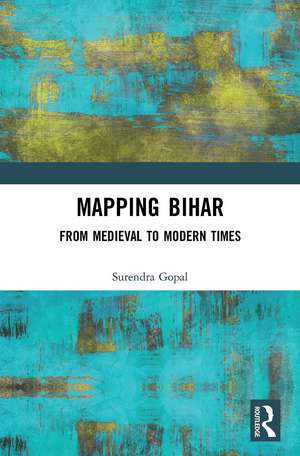Mapping Bihar: From Medieval to Modern Times
Autor Surendra Gopalen Limba Engleză Paperback – 25 iun 2024
At the turn of the nineteenth century, Industrial Revolution began in Britain.
The East India Company stopped trading in textiles. Instead, they promoted cotton cultivation in order that cotton was available to British textile factories. They promoted cultivation of indigo, needed by the textile manufacturing factories coming up. Land revenue source of the government's prime income, was collected even when agricultural output suffered massively. The government took deep interest in opium production but paid the cultivators less than the market price. British interference in agricultural matters caused wide spread agrarian distress.
Indian society encountered many socio-religious reform movements. Raja Rammohun Roy and Swami Dayanand were major proponents of the new order. Stress was laid on gender equality, women empowerment and the modern system of education. Institutions for training doctors, engineers and scientists were opened. As time progressed, by and large, Biharis accepted the changes. Eventually social reform movements turned into the freedom movement in which Biharis played a leading role.
This comprehensive volume is indispensable for scholars working on Bihar and modern and medieval South Asia.
Please note: Taylor & Francis does not sell or distribute the Hardback in India, Pakistan, Nepal, Bhutan, Bangladesh and Sri Lanka
Preț: 263.56 lei
Preț vechi: 328.36 lei
-20% Nou
Puncte Express: 395
Preț estimativ în valută:
50.43€ • 52.76$ • 41.89£
50.43€ • 52.76$ • 41.89£
Carte tipărită la comandă
Livrare economică 02-16 aprilie
Preluare comenzi: 021 569.72.76
Specificații
ISBN-13: 9781032653259
ISBN-10: 1032653256
Pagini: 464
Dimensiuni: 152 x 229 mm
Greutate: 0.63 kg
Ediția:1
Editura: Taylor & Francis
Colecția Routledge
Locul publicării:Oxford, United Kingdom
ISBN-10: 1032653256
Pagini: 464
Dimensiuni: 152 x 229 mm
Greutate: 0.63 kg
Ediția:1
Editura: Taylor & Francis
Colecția Routledge
Locul publicării:Oxford, United Kingdom
Public țintă
PostgraduateCuprins
1. Ideas in Ancient and Medieval Bihar 2. Bihar Peasants in the Early Decades of the Eighteenth Century 3. Changing Bases of Peasant Movement in Bihar, 1917-1975 4. Peasant Movement in Bihar during the Second World War (Some Newspaper Sources) 5. Opium Raiyats in Bihar in the First Half of the Nineteenth Century 6. Revenue Roll Registers: An Aid for Quantitative Study of Agrarian History of Bihar in the Nineteenth Century 7. Beginnings of Peasant Protest against European Indigo Planters in Bihar 8. Small Towns in Bihar in the First Half of the Nineteenth Century (A Study in the Character of Urban Growth) 9. A New Pattern of Urban Growth: Emergence of Zamindari Towns in Bihar (A Case Study of Dumraon in the Second Half of the Nineteenth Century) 10. Endeavour and Persistence: Brahmo Samaj in Bihar in the Second Half of the Nineteenth Century 11. Swami Dayanand, Bihar and Arya Samaj 12. Dalits in Bihar: A Historical Study 13. The Roots of Conservatism and Casteism: A Study of Social Change in Bihar in the Second Half of the Nineteenth Century 14. An Elite Group in the Second Half of the Nineteenth Century in Bihar 15. Industrial Capitalism and Entrepreneurship in Bihar in the Nineteenth Century 16. Socio-Cultural Contours of Patna at the Turn of the Twentieth Century 17. European Accounts of Bihar in the Second Half of the Eighteenth Century 18. Bihar in the Eyes of British Travellers and Painters, 1780-1850 19. Aniruddha Ray on European Discourses on Bihar 20. Science College, Patna, 1927-1947 21. Munshi Binayak Prasad: A ‘Native’ History-writer
Notă biografică
Surendra Gopal served as Lecturer, Reader and Professor in History Department, Patna University between 1958 and 1996. Along with teaching he carried out significant research work. The result has been more than 100 research papers and eight books. His latest book is Born to Trade: Indian Business Communities in Medieval and Early Modern Eurasia (2016).
Dr. Gopal has collected data for his works from English, Hindi, Urdu, Bengali and Russian sources.
Dr. Gopal has collected data for his works from English, Hindi, Urdu, Bengali and Russian sources.
Descriere
Written Indian history begins in 6th century bc with the history of Magadh (present day states of Jharkhand & Bihar). For almost a millennium Magadh dominated Indian history. The Mughals ensured Bihar's economic prosperity; Patna became the most important centre of Himalayan trade. In the mid-eighteenth century Bihar & Bengal fell into t
